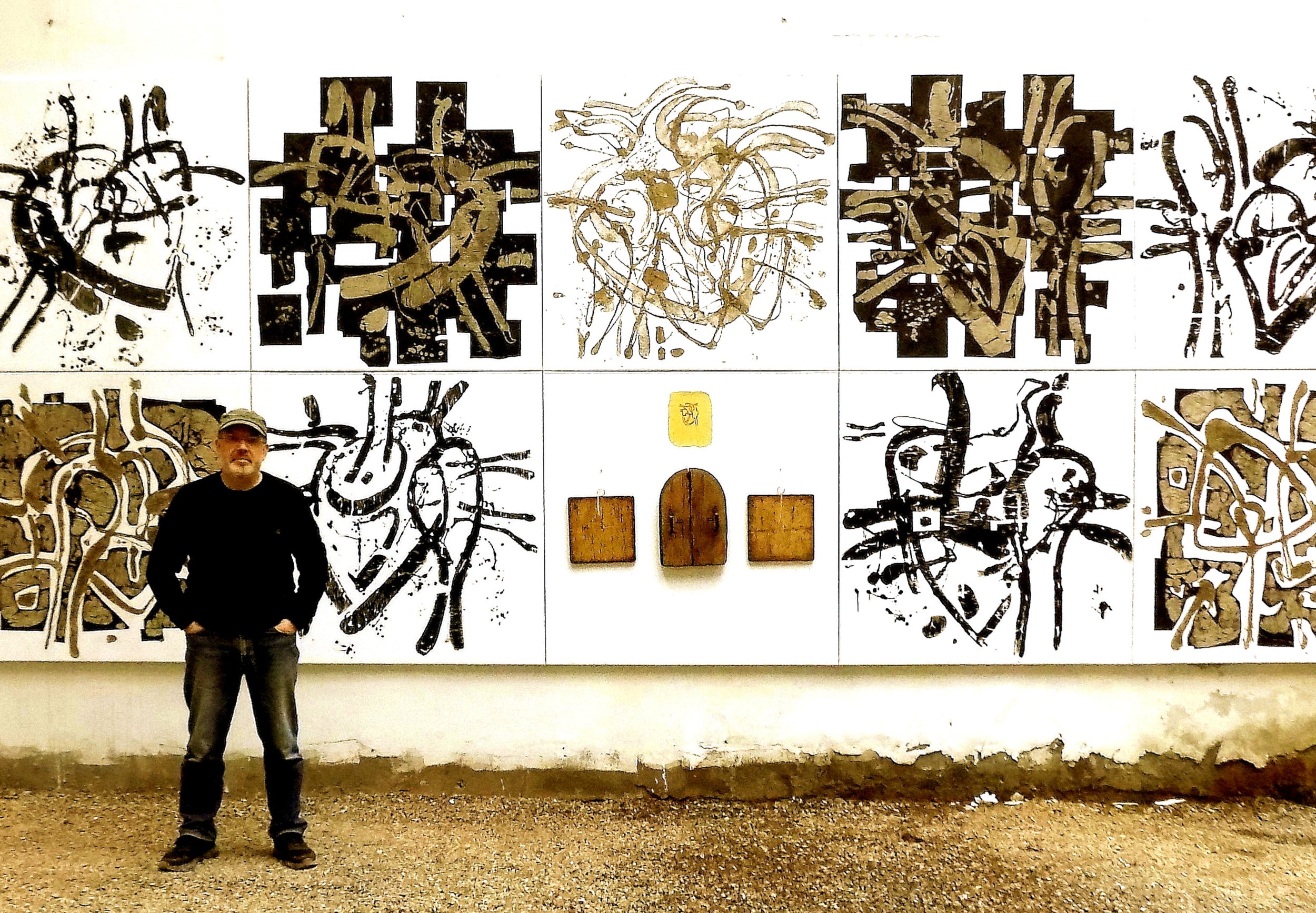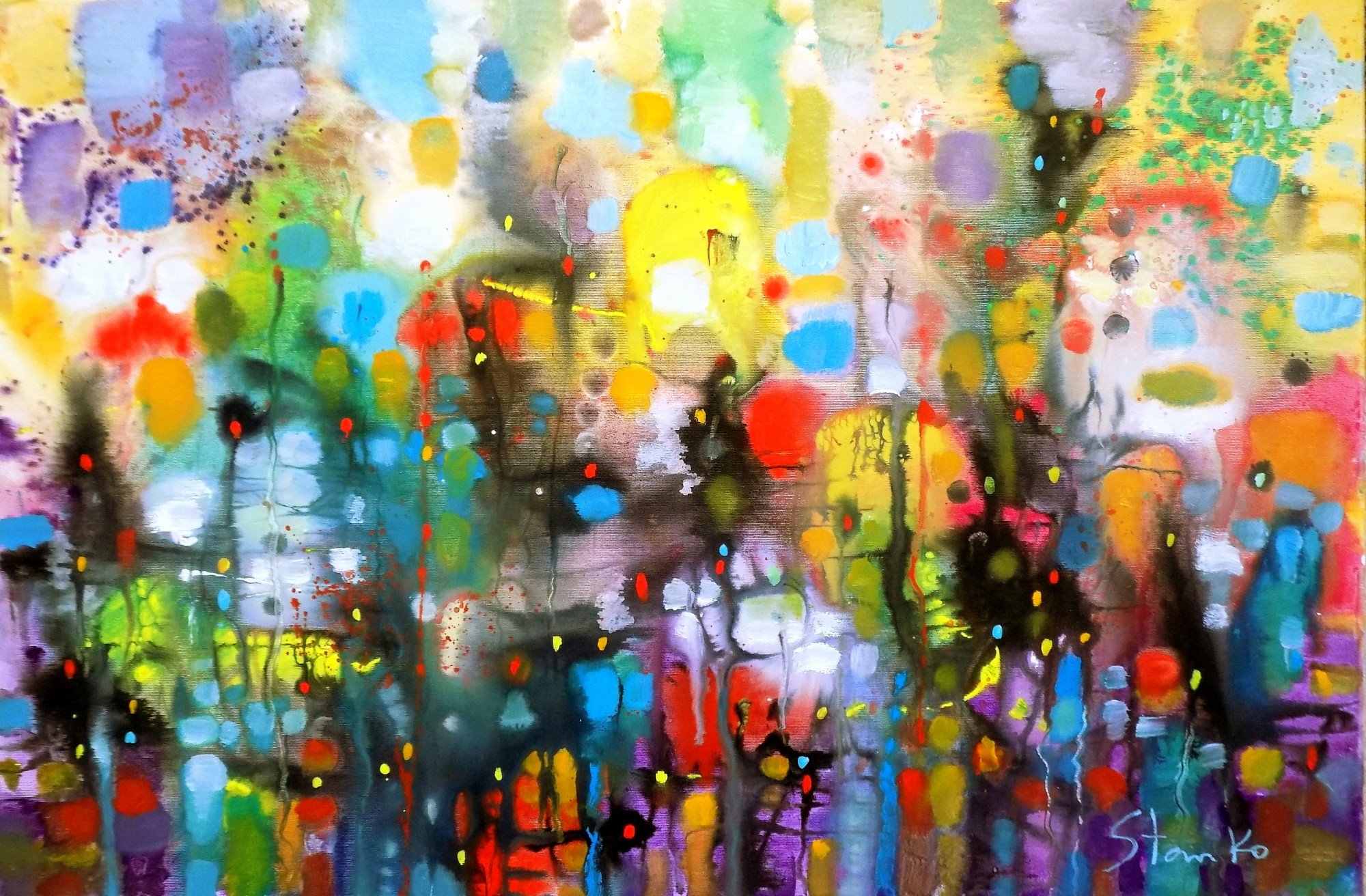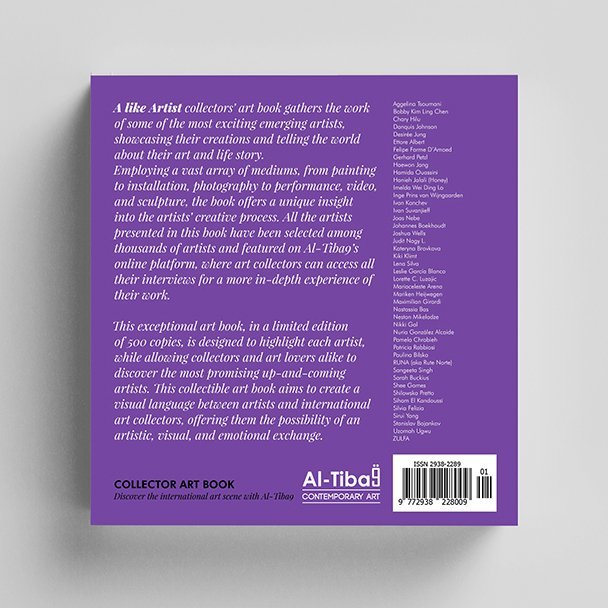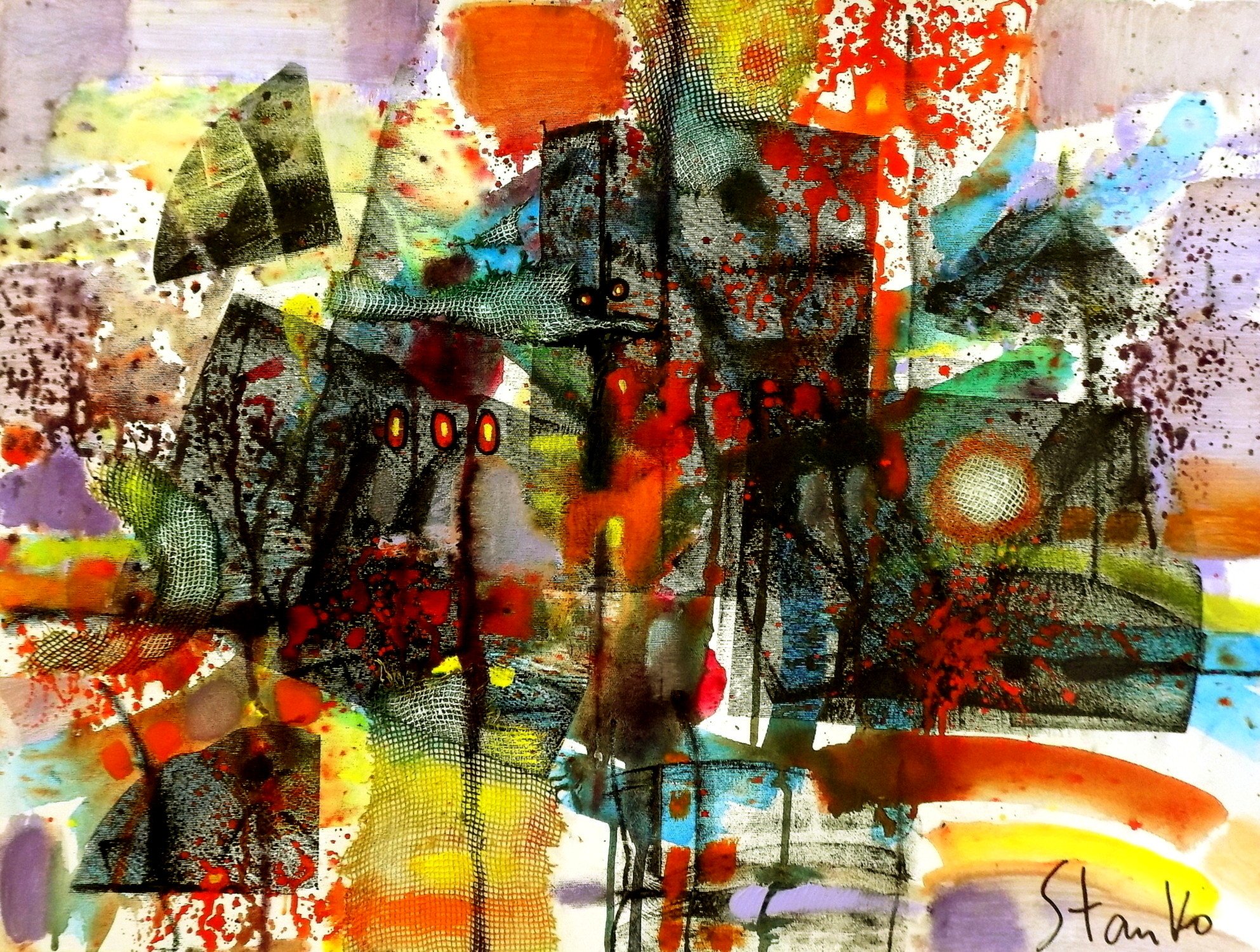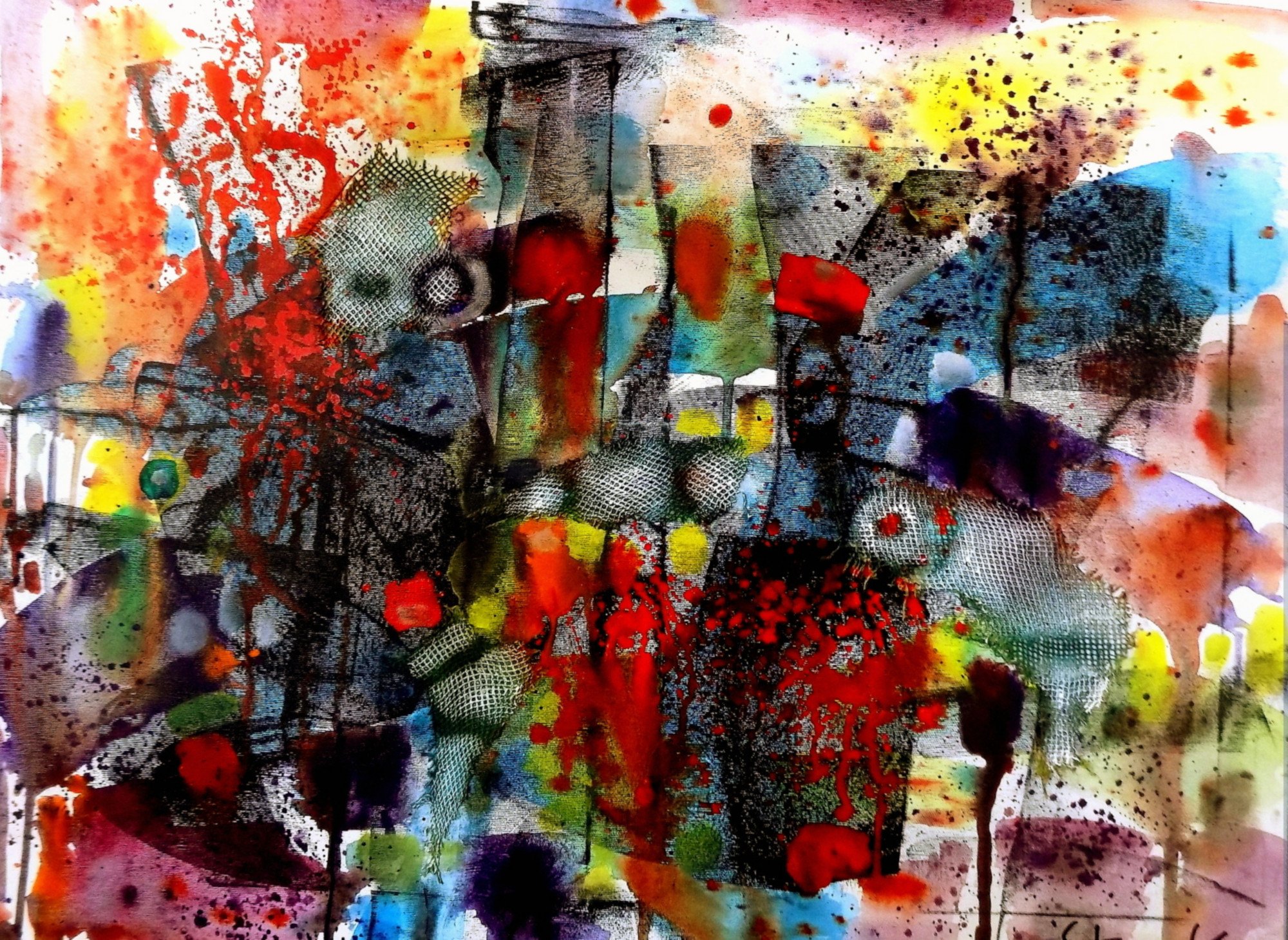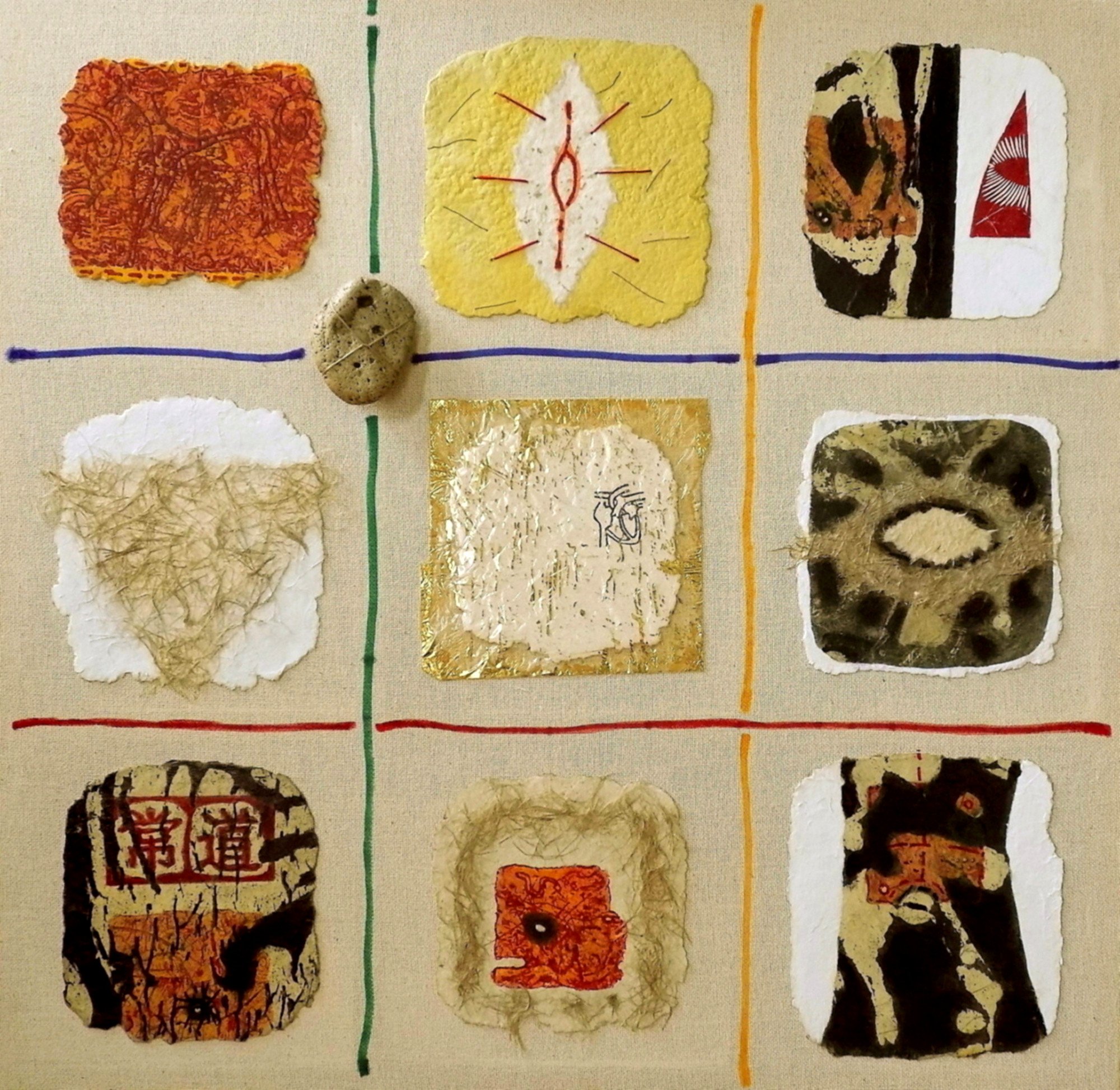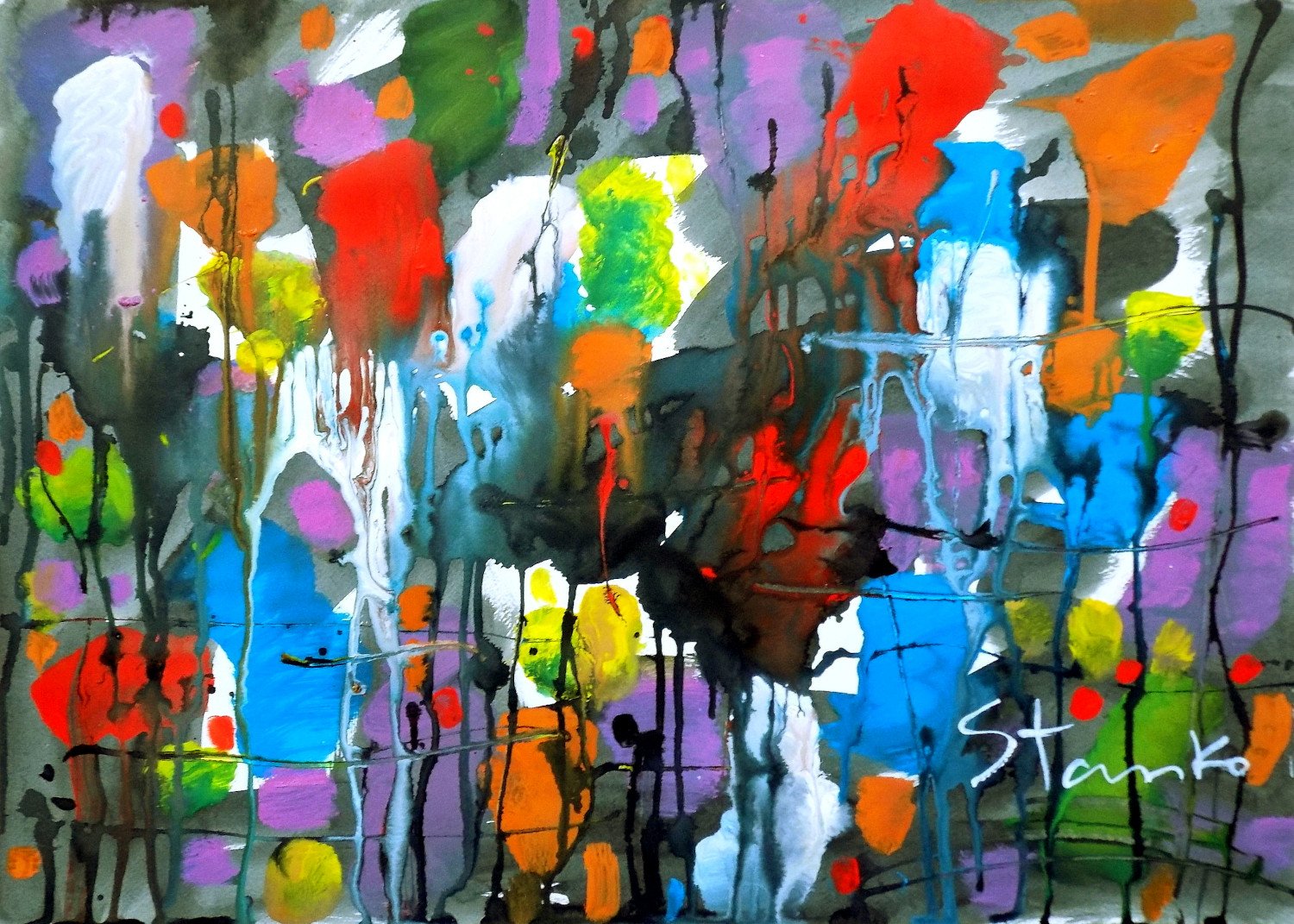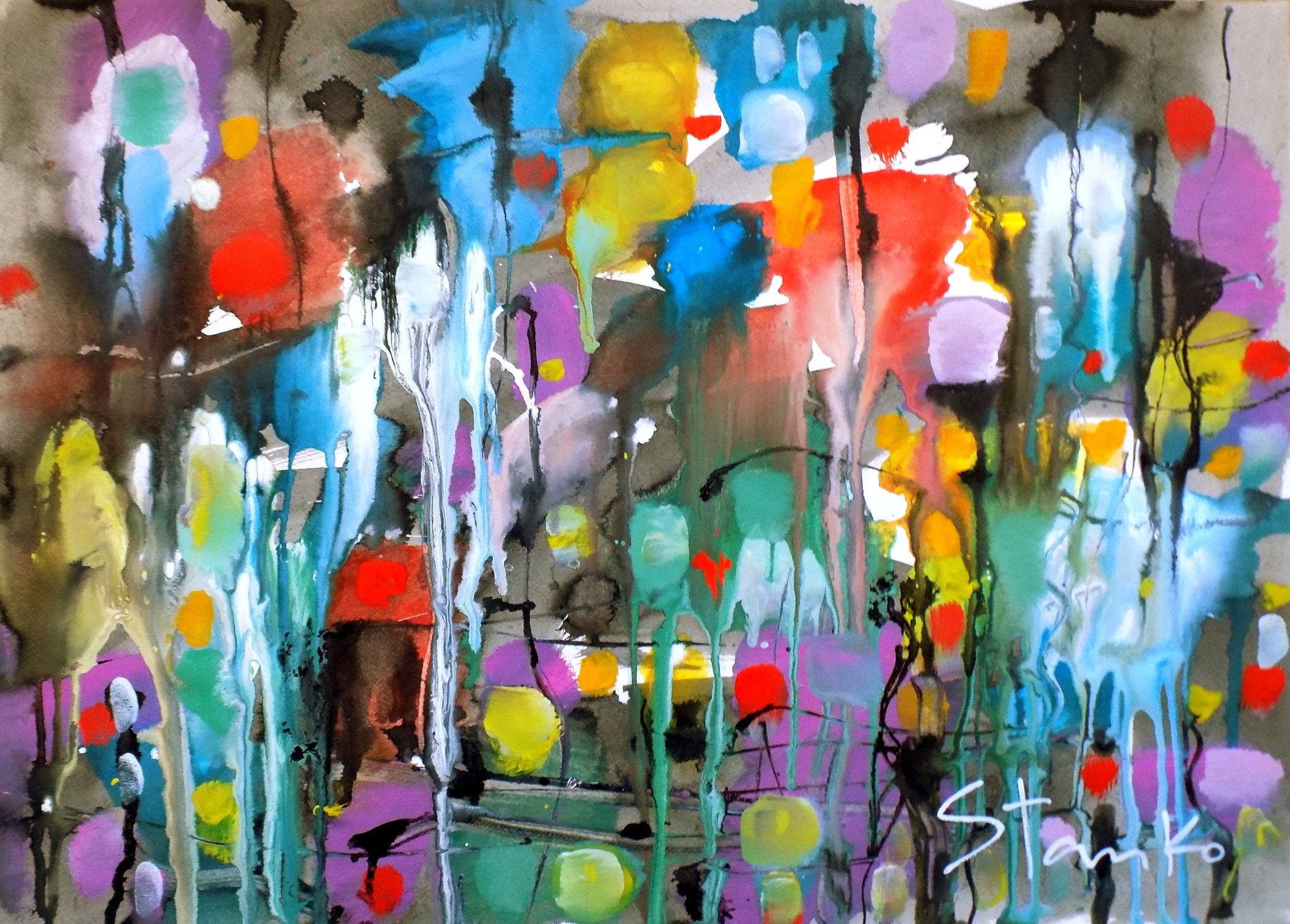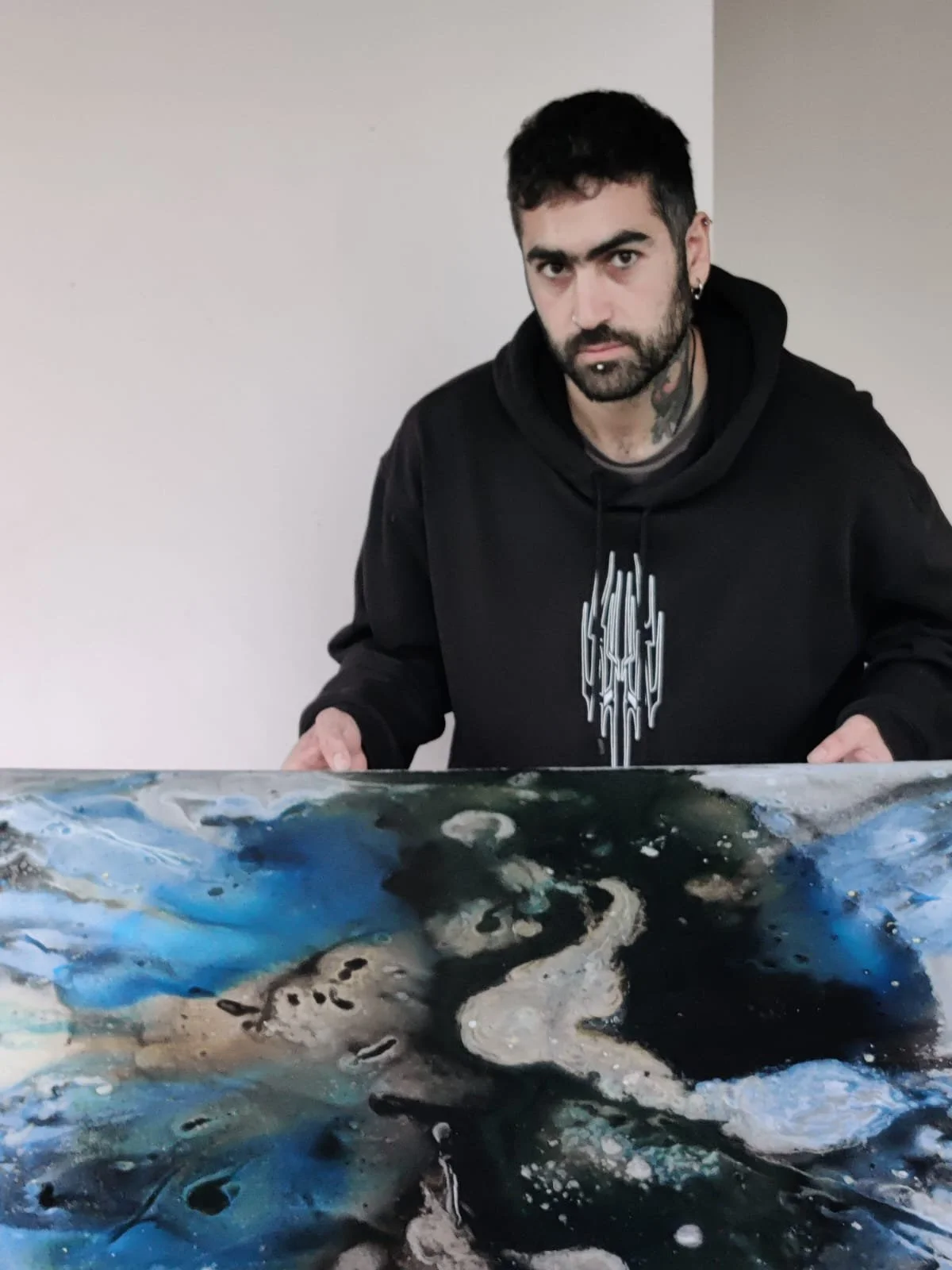10 Questions with Stanislav Bojankov
Stanislav Bojankov was born in 1966 in Bulgaria. He got his MFA in Printmaking in 1995, at the Academy of Fine Arts in Cracow, Poland, with Prof. Andrzej Pietsch. Currently he works in the areas of Painting, Drawing and Graphic Design. He has exhibited his works in solo and group shows, biennials and triennials both nationally and internationally. So far, he has participated to nearly 400 exhibitions around the world.
Stanislav Bojankov - Portrait in his studio
ARTIST STATEMENT
The horizon of the existence of phenomena – thought, time, and space – in which the echo of the individual’s traces of existence is one with the necessity to be with that which is distant, yet primary, is identified with The Roots.
The Roots – prehistory, classical antiquity, orthodoxy, the enigma of voices and incantations, existentialism; the Ego as a particle of matter, scattered amongst the romantic autonomy of the fatherland, reveal a particular visualisation, one of a feeling of unity amongst the collective perceptions and their comprehension.
Through my work, I wish to contribute to these local and global cultural traditions and simultaneously create new expectations within the modern individual’s universal perceptions, transforming them into widely understood signs, symbols, and codes. This is an honest and true route in exploring the global through the local.
Just rainy XXXVIII, Acrylic on canvas, 60x90cm, 2020 © Stanislav Bojankov
Limited edition art collectors’ book
INTERVIEW
First, why are you an artist, and when did you first decide to become one?
This is actually the most important question. This is the question of questions. And all our lives, in our works, artists do just that - we try to respond to it. Perhaps in order to filter reality through our personal, intellectual, and mental accumulations, to express our feelings, emotions, vibrations, peculiar daily life, and attitude in the contexts of modern, social, cultural, and civilizational processes. And perhaps, the role of the artist as meaning is intellectual and educational - by creating images and messages that enrich our spiritual journeys and seek the spiritual heights and attitudes in life. There is a kind of "sacralization" of life in the very process of "making" art, a mystical connection with the creative energies of Homo sapiens and their release in the form, thought, verse, or musical phrase. Otherwise, I have been painting since I have memories of myself. From a young age, somewhere in my childhood were my first attempts at self-knowledge, definition, and analysis of what is around us, as well as a sample to explain it. I was not a big fan of children's games, and after a short flirtation with football, I chose to paint, read literature and poetry, listen to music, and delve into different ideas, thoughts, and dreams.
What is your personal goal as an artist?
Art has always been at the top of the value pyramid of values. The artifacts left by countless creative generations, carrying all the love, emotions, and meaning for themselves, are at the core of our value accumulations. I am inspired by everything - philosophy, music, nature, mythologies, beauty, and ugliness, good and bad - such as our lives - a symbiosis, a kaleidoscope of all this, a "game of glass beads" (according to Hermann Hesse), a utopia, "Puzzle-installation", which we call "life" for short. Art is the direct proof that there is real life on our suffering planet. And in this aspect are my attempts, in search of the universal codes of modern man, in defining his global presentiments and hypotheses, in the direction of the high and beautiful flights of the imagination.
Improvisation I, Acrylic on canvas, 60x80cm, 2020 © Stanislav Bojankov
Improvisation III, Acrylic on canvas, 60x80cm, 2020 © Stanislav Bojankov
How has your practice developed over the years? And how would you define yourself as an artist today?
I like my career, and I don't want anyone else's. Only I know the difficulties and obstacles I had to deal with in the difficult path of a freelance artist living in a poor post-communist country, far from the free and quality art market. I completed my art education in the mid-1990s at the Krakow Academy of Fine Arts in Poland, one of the oldest schools in Europe, where I received a traditional education studying basic technologies. This allowed me to start working in many different fields - painting, graphics, drawing, collage, and making installations and objects.
Gradually, in the process of working, solving various technological, creative, and conceptual problems, I had to educate myself and experiment with technology and materials. I also created my own handmade paper. And my work developed in direct connection with the existential and purely human impulses from everyday life, emotions, thoughts, and traces of life (here and now) in the context of a personal journey. Yes, it can be said that art also has a therapeutic effect on the viewer and its creator. And it is no coincidence that when I am separated from my studio for some reason, it does not reflect well on my spirit, feelings, and self-confidence. I'm used to visiting my studio every day.
Your work revolves around topics such as harmony and traditions. Where do you get inspiration for your work?
I live in a beautiful province south of Sofia. Bulgaria is very gifted with natural resources and beauty - with mountains and sea. It has been at the crossroads of various civilizations throughout its history, from primitive societies, cave art, and the Neolithic, through the ancient Greek and Thracian civilizations, the Roman Empire, orthodox Byzantium, Ottoman civilization, and the Orient. Thanks to these cultures, historical, intellectual, religious, and mythological background of unique archetypes has been created, which is unique in terms of broadcasting and messages. I attempt to give an understanding, to be in modernity, using the codes of my traditional cultural layers and roots and my personal cultural DNA, and through them to be "contemporary" and relevant in my messages globally. The current state of visual forms is characterized by a special "hybridity" that cannot be defined - without dominant styles, without trends, with many different technological techniques, multimedia, basic conceptuality - a huge vast ocean of values and pseudo values in which the artist can very easily drown if he is not as sure as in his messages, so in the depths of his own cultural layers, and his existential reasons to look right there - "with himself" his inspirations and meaning as an artist. This is the honest way. And through this personal filter to be global in our common "puzzle" of values.
Sub-Statio-I, Selfmade papers, collage, 67x66cm, 2015 © Stanislav Bojankov
What is your creative process? And how did you develop this way of working?
I have two trips to work. The first is emotional - energies that I try to master through various means of expression, mainly watercolors, acrylics, drawings, and monotypes while trying to enjoy the spontaneity of the process. Just as a composer creates his music, extracting abstract sounds from the depths of his mind that express his feelings, emotions, and personal vibrations, such are my series of abstract landscapes inspired by jazz or my favorite Chopin. It's almost a kind of intellectual "jam session". The second campaign is conceptual: first, I choose the sentence, the important message or thought that I want to create, and then I choose the technique, means of expression, and form. These are important philosophical or existential issues. I work in different formats - my biggest works are painting installations of 840/240 cm, and the smallest is as many as matchboxes. I prefer medium formats, something like the middle way in Eastern philosophies. In fact, I've been a freelancer all my life. I work every day in my studio, and it pays my bills. I draw, read books and poetry, listen to a lot of different types of music - mostly jazz, classical, and ethno-world, and this is the intellectual background of the creation process. I'm in my studio every day. Without it, I feel nervous and often dissatisfied because I miss the magic of this ritual of self-expression and self-knowledge. And this is a special "intellectual hunger", an addiction without which our work is doomed. My studio is full of sounds. Many of those charge me, inspire me, and provide a background to the feelings. I live in a small and quiet town in the south and I get up early in the morning, walk, drink coffee in one of the city cafes, get ready for work, plan tasks, and then go to the studio. I also take care of my old parents. In the afternoon I go around the city, the cafes again and go back to the studio, I work with the camera and the computer. The most creative thoughts come to me when I'm on my bike. And I usually don't fix my works - I like to get it from the first time, to keep my initial impulses and moods built into the gesture, in the same way a jazz musician improvises on his score, without fear of failure, following his momentary intuitions and feelings. They are the most sincere and close to nature. Usually, the topics themselves appear somewhere "inside" the process. I just let them guide me and "insert" them into certain materials and technology. It can be said that I am an "intuitive" type of artist, for whom spontaneity is the main energy and tool of creativity.
Which aspect of your work do you pay special attention to?
Of course, we cannot do without the political and intellectual context in which we live. It is the natural environment in which we develop, emotionally and mentally. We observe ourselves, see the realization of our intellect and talent, and the result of our activities. Moreover, we are very connected with social communication, and we cannot do without it. Evidence of this was the forced isolation and distance during the covid crisis and the difficult way of overcoming emotional and psychological tension and stress as a consequence of the lack of social context and human love and communication. And now, the war in old Europe is further fueling tensions in our civilizational and value spaces, which are accustomed to building and creativity.
Is there a piece that you consider a "breakthrough" in your career?
During the pandemic, I created my last installation, Large heart iconostasis 2, an 840x240 cm black and white painting with related objects, which in early April, I exhibited in a very prestigious and alternative space in the City Gallery in Kyustendil. A piece that may not be a "breakthrough", but it closes, makes sense and builds on my search since my early steps in the 90s. So the pandemic, in its own strange way, paid off in my studio too.
Just Rainy LIII, Acrylic on paper, 50x70 cm, 2020 © Stanislav Bojankov
Just Rainy-LIV, Acrylic on paper, 50x70 cm, 2020 © Stanislav Bojankov
What do you think about the art community and the market? And how has your perception changed over the last year due to the pandemic?
Social media has long caused a revolution in the art world. We artists have become much more communicative and have reached our fans and collectors faster. It is also very important that we receive evaluations and opinions from the audience much better and faster - feedback is essential in our profession. And all this created a much better environment for development and realization. Most galleries are now "hybrid", stationary and virtual. You can work with your gallery or collectors from anywhere in the world, except you can't have a drink together.
Pressing is from the commercialism of the times in which we live. Of course, the artist must be able to command himself, refuse orders sometimes, and have self-discipline. And these are things that are being built gradually. In itself, art has long been not what we once called it. Looking at it from the current point of view, and not only because of the great opportunities and "ease" and availability of new technologies and the digitalization of our daily lives, one can very easily "slide" to a pseudo-contemporary approach and lose themselves and their roots. But the creation processes remain "magical" and "mystical" - a kind of spiritual practice of self-awareness. The pandemic surely destroyed many social ties, yet it also created and gave some new chances and opportunities.
What are you working on now and what are your plans for the future? Can you tell us something exciting?
I am currently in the process of restarting. I'm doing repairs in my studio and cleansing the old energies after the pandemic. I think of new things, rich in color, emotions, feelings, and love, which are deep and full of different meanings. And the audience to choose, feel, and empathize. We need, in general, new air and a new spring in our spiritual spaces, especially in this post-pandemic period. Аnd in the context of this insane war.
Finally, what is a piece of advice you would give to an emerging artist?
Our main work is with ourselves - self-knowledge in the process of creation, ennobled by good energies, which are the most important tool of the artist. "Making" art is a special and difficult activity associated with the most intimate mental and intellectual vibrations and requires special dedication and conviction. It gives, in its specific way, a kind of personal freedom to people who are dedicated to creating. It is an area in which one cannot afford to be dishonest or bad, to lie and speculate on emotions and ideas. This is always visible and transparent through form and analysis, no matter how well disguised.


